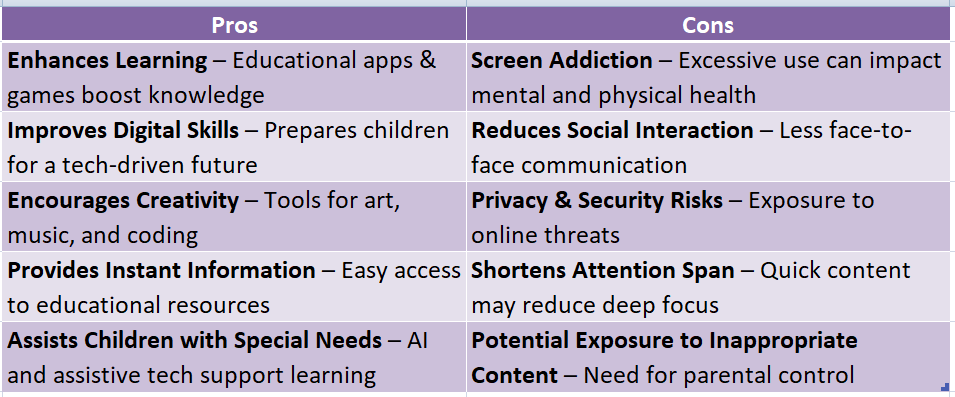
In today’s digital age, understanding how technology impacts children’s learning and development is crucial. Technology and children are intertwined in ways that enhance educational experiences, making learning more interactive and engaging. With the right tools, educators can foster an environment that promotes creativity and critical thinking.
Enhancing Learning Experiences
Technology provides various resources that cater to different learning styles. For instance, visual learners benefit from educational videos, while auditory learners thrive with podcasts. Additionally, technology and education statistics reveal that students using digital tools often show improved retention rates and engagement levels.
How Can Students Use AI in School
AI is revolutionizing the classroom experience. Here are some ways students can leverage AI:
- Personalized Learning: AI can tailor educational content to meet individual needs.
- Instant Feedback: Students receive immediate responses on assignments, aiding in quicker learning.
- Research Assistance: AI tools help students find relevant information efficiently, enhancing their research skills.
The Future of Technology in Education
As technology continues to evolve, its role in education will expand. Schools are increasingly integrating tech into curricula, preparing students for a tech-driven world. Embracing technology not only supports academic growth but also equips children with essential skills for their future careers.
Unlock your potential with online degrees—Learn more!
How Does Technology Enhance Cognitive Development in Children?
In today’s digital age, understanding how technology impacts children’s learning and development is crucial. With the integration of various tech tools in education, children are not just passive recipients of information; they actively engage with content, enhancing their cognitive abilities. This section explores how technology enhances cognitive development in children, making learning more interactive and effective.
Interactive Learning Experiences
Technology and children go hand in hand, providing interactive platforms that stimulate critical thinking. For instance, educational apps and games encourage problem-solving skills and creativity. These tools allow children to explore concepts at their own pace, fostering a deeper understanding of subjects.
AI in Education
How can students use AI in school? AI tools can personalize learning experiences, adapting to each child’s unique needs. By analyzing performance data, AI can suggest resources tailored to individual learning styles, making education more effective and engaging. This personalized approach not only boosts academic performance but also builds confidence in learners.
Technology and Education Statistics
Recent technology and education statistics reveal that students who engage with digital tools tend to perform better academically. Studies show that interactive learning environments can improve retention rates and enhance overall cognitive development. As technology continues to evolve, its role in education will only become more significant, shaping the future of learning.

Are There Risks Associated with Technology Use Among Children?
In today’s digital age, understanding how technology impacts children’s learning and development is crucial. While technology offers numerous educational benefits, it also presents potential risks that parents and educators must navigate. As we explore these risks, it’s essential to consider how technology and children interact in various learning environments.
Screen Time and Attention Issues
Excessive screen time can lead to attention problems. Studies show that children who spend too much time on devices may struggle with focus in traditional learning settings. This is particularly concerning when considering technology and education statistics, which indicate a correlation between high screen time and decreased academic performance.
Social Skills Development
Another risk is the impact on social skills. Children who engage more with screens than with peers may miss out on crucial face-to-face interactions. This can hinder their ability to develop empathy and effective communication skills, which are vital for their overall development.
Cyberbullying and Online Safety
Lastly, the internet can expose children to cyberbullying and unsafe content. Parents must educate their children about online safety and encourage responsible technology use. How can students use AI in school? By leveraging AI tools responsibly, they can enhance their learning while minimizing risks.
The Impact of Educational Apps on Children’s Learning Outcomes
In today’s digital age, understanding how technology impacts children’s learning and development is crucial. With the rise of educational apps, parents and educators are increasingly interested in how these tools can enhance learning outcomes. The integration of technology in education not only engages students but also provides personalized learning experiences that cater to individual needs.
Engaging Learning Experiences
Educational apps transform traditional learning by making it interactive and fun. Children are more likely to engage with content that is visually appealing and gamified. This engagement can lead to improved retention of information and a deeper understanding of complex concepts.
Personalized Learning
Apps often use algorithms to adapt to a child’s learning pace. This means that students can receive tailored content that challenges them appropriately. For example, technology and education statistics show that personalized learning can significantly boost academic performance, especially in subjects like math and reading.
How Can Students Use AI in School
AI-powered educational tools can assist students in various ways. From providing instant feedback on assignments to offering tutoring support, these technologies empower children to take charge of their learning. By leveraging AI, students can explore subjects more deeply and develop critical thinking skills.
Unlock your potential with online degrees—Learn more!
Can Technology Foster Social Skills in Children?
In today’s digital age, understanding how technology impacts children’s learning and development is crucial. With the rise of educational tools and platforms, parents and educators are increasingly exploring how technology can enhance social skills among children. This section delves into whether technology can indeed foster social skills in children, a vital aspect of their overall development.
Enhancing Communication Skills
Technology and children often intersect in ways that promote communication. Through platforms like video calls and messaging apps, children can connect with peers, enhancing their ability to express thoughts and emotions. This interaction is essential for developing empathy and understanding, key components of social skills.
Collaborative Learning Opportunities
- Group Projects: Online tools allow students to collaborate on projects, teaching them teamwork and negotiation skills.
- Discussion Forums: Engaging in online discussions helps children articulate their ideas and listen to others, fostering respectful dialogue.
- AI in Education: How can students use AI in school? AI tools can facilitate group learning experiences, making collaboration more accessible and effective.
Technology and Education Statistics
Research shows that 75% of teachers believe technology improves student engagement. Moreover, studies indicate that children who use technology for collaborative learning exhibit stronger social skills. This highlights the potential of technology to not only support academic growth but also enhance interpersonal relationships among peers.
How Parents Can Effectively Integrate Technology into Learning
In today’s digital age, understanding how technology impacts children’s learning and development is crucial for parents. With the right integration, technology can enhance educational experiences, making learning more engaging and accessible. However, it’s essential to strike a balance to ensure that technology serves as a tool for growth rather than a distraction.
Set Clear Guidelines
Establishing boundaries around technology use is vital. Parents should set specific times for educational activities and recreational screen time. This helps children understand the difference between learning and leisure, promoting a healthy relationship with technology.
Encourage Interactive Learning
Utilizing educational apps and games can make learning fun. For instance, platforms that incorporate AI can personalize learning experiences. How can students use AI in school? They can use AI tools for tutoring, homework assistance, and even language learning, making education more tailored to their needs.
Monitor Progress with Technology and Education Statistics
Keeping track of how technology influences learning outcomes is essential. Parents can refer to technology and education statistics to assess the effectiveness of various tools. This data can guide decisions on which technologies to adopt or limit, ensuring that children benefit from their digital experiences.
Discover How CollegeAndTuition.com Supports Technology and Children’s Development
In today’s digital age, understanding how technology impacts children’s learning and development is crucial. With the rise of educational tools and resources, technology and children are intertwined more than ever. This relationship can enhance learning experiences, foster creativity, and prepare students for future challenges.
The Role of Technology in Learning
Technology in education has transformed traditional learning methods. It provides access to a wealth of information and interactive tools that engage students. For instance, how can students use AI in school? AI can personalize learning experiences, adapting to each child’s pace and style, making education more effective and enjoyable.
Benefits of Technology in Education
- Enhanced Engagement: Interactive platforms keep children interested.
- Access to Resources: Students can explore diverse materials online.
- Collaboration Opportunities: Technology fosters teamwork through shared projects.
Technology and Education Statistics
Recent statistics reveal that over 70% of teachers believe technology positively impacts student learning. This data underscores the importance of integrating technology into educational frameworks, ensuring that children develop essential skills for the future. By embracing these advancements, CollegeAndTuition.com is committed to supporting children’s development in a tech-savvy world.
Unlock your potential with online degrees—Learn more!
FAQs
-
At what age should children start using technology?
Children can start engaging with technology as early as infancy, but screen time should be limited and age-appropriate. The American Academy of Pediatrics (AAP) recommends minimal screen time for children under 2 and guided use for older kids. -
How does technology affect children’s development?
Technology can enhance learning, creativity, and problem-solving skills, but excessive use may impact social skills, attention span, and physical health. -
What are the benefits of technology for children?
Technology can improve access to information, enhance learning experiences, develop digital literacy, and encourage creativity through educational games and apps. -
What are the risks of excessive screen time?
Too much screen time can lead to reduced physical activity, sleep disturbances, eye strain, and social isolation.





